It’s the most surreal twist in financial history: the anonymous creator of Bitcoin — a digital currency born out of rebellion against centralised money — is now the 11th richest person in the world. The fact that Satoshi Nakamoto is the 11th richest person globally is astounding. Without a face, without a voice, and without spending a single coin, Satoshi Nakamoto has climbed past business titans and tech moguls, fuelled purely by the explosive growth of the decentralised asset he created.
According to on-chain analytics firm Arkham Intelligence, Satoshi is believed to control 1.096 million Bitcoins, distributed across thousands of early wallets dating back to 2009 and 2010. With Bitcoin’s recent surge to $121,659 per coin, that holding is now worth over $131 billion.
And just like that, Satoshi Nakamoto 11th richest, is no longer a speculative clickbait headline — it’s a mathematically accurate, blockchain-verified fact. What makes it even more extraordinary is this: Satoshi hasn’t moved a single Satoshi from those wallets in over 15 years.
Not to spend. Not to reinvest, and not even to cash out during the 2021 bull run.
This isn’t just a story about wealth. It’s about anonymity, discipline, and the unstoppable momentum of an idea that changed the very definition of money.
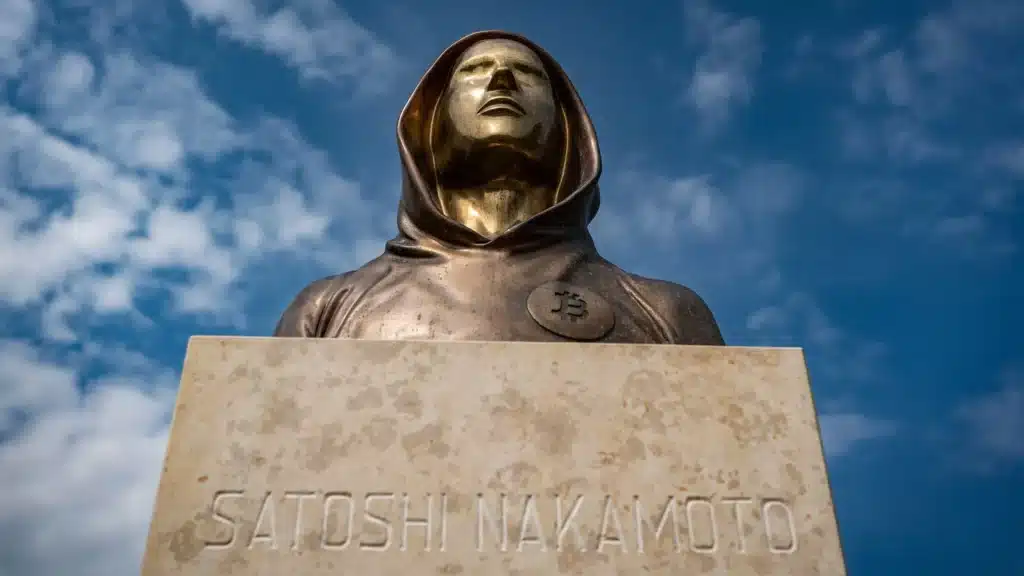
Who is Satoshi Nakamoto?
That question remains one of the internet’s greatest unsolved mysteries.
Satoshi Nakamoto is the pseudonymous author of the Bitcoin whitepaper, published in October 2008, and the original developer of the Bitcoin software, which launched the following January. Satoshi corresponded with early contributors on cryptographic forums and email, then quietly disappeared in 2010, handing over the GitHub repository and disappearing completely from public communication.
To this day, no one has ever been able to definitively identify Satoshi. The guesses have ranged from Hal Finney, the late cryptographer who received the first Bitcoin transaction, to Nick Szabo, an early smart contracts theorist, and even Dorian Nakamoto, a Californian engineer falsely outed by Newsweek.
While many have speculated, none have proven. The wallets remain untouched. The mystery remains intact.
Satoshi’s net worth by the numbers
Let’s break down how the numbers lead to the Satoshi Nakamoto 11th richest milestone.
- Total Bitcoin held: 1.096 million BTC
- Current BTC price (as of Sunday): $121,659
- Total value: approx. USD 133.4 billion
- Current Forbes #11 (Michael Dell): $125.1 billion
- Satoshi’s ranking: Above Michael Dell, just behind Warren Buffett ($139B)
This calculation comes directly from wallet analysis tools like Arkham and Nansen. They use block history to identify addresses believed to be linked to early mining activity exclusive to Satoshi’s operation.
Importantly, the estimated wallet set hasn’t changed in years. No movements. No transfers, and no coin joins. That in itself has become part of Satoshi’s legend — the idea of a trillion-dollar creator never touching the wealth he mined.
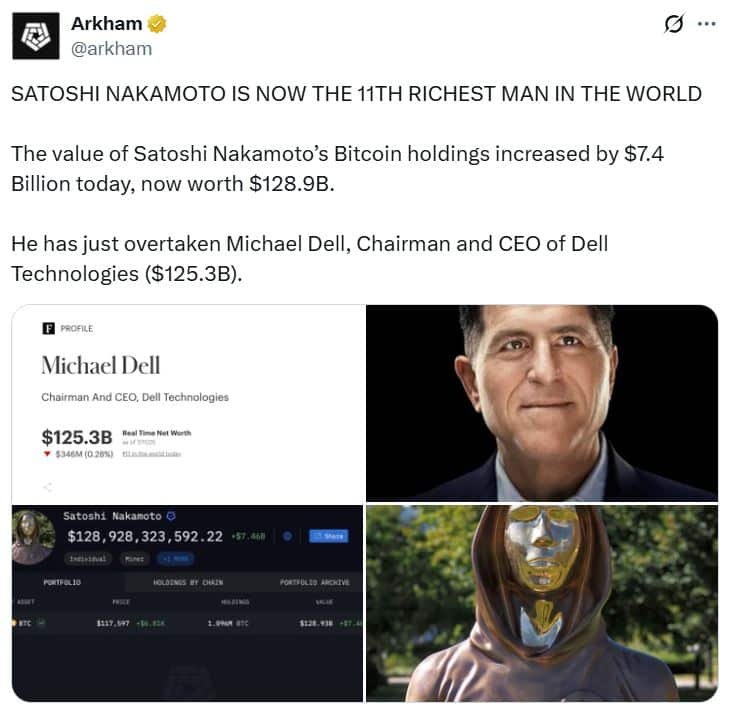
Why this ranking matters
At a glance, it might seem like a novelty — a ghost with a billion-dollar stash. But in the world of financial rankings, it breaks every norm.
Forbes, Bloomberg Billionaires Index, and other wealth trackers typically measure fortune based on public, verifiable assets like stocks, company ownership, and property. They do not normally include anonymous crypto wallets, precisely because they can’t always attribute ownership.
In this case, though, the attribution is nearly unanimous in the crypto space. The 1.096M BTC attributed to Satoshi comes from an early mining pattern called the Patoshi pattern — a forensic signature in the block timestamps and nonce values of mined Bitcoin from 2009. According to researchers like Sergio Lerner, no one else could have mined those coins.
If any wealth deserves acknowledgement, it’s this one. And it redefines what modern wealth even means — proof-of-work validated, publicly traceable, yet personally anonymous.
Could Satoshi become the world’s richest person?
That’s the big question. And the answer is: yes, but it depends on two things:
- Bitcoin’s price is climbing significantly
- Other billionaires’ fortunes remaining static
Let’s run the maths. As of mid-2025:
- Elon Musk leads the list with a net worth of $404 billion
- Larry Ellison and Mark Zuckerberg follow, each with approximately. $274 billion
- Satoshi, with $133B, needs Bitcoin to hit approximately $370,000 per coin to overtake Elon Musk
That represents a 208% increase from current BTC levels — ambitious, but not unimaginable in the context of past bull runs.
Crypto market veterans like Arthur Hayes predict $250K Bitcoin by the end of 2025. Matt Hougan, CIO of Bitwise, has publicly called for $200K Bitcoin by the end of next year, citing rising institutional demand and a “supply shock” following 2024’s halving event.
Bloomberg ETF analyst Eric Balchunas even projected that if Bitcoin continues its historic 50% annual growth, Satoshi could become the second-richest person by 2026.
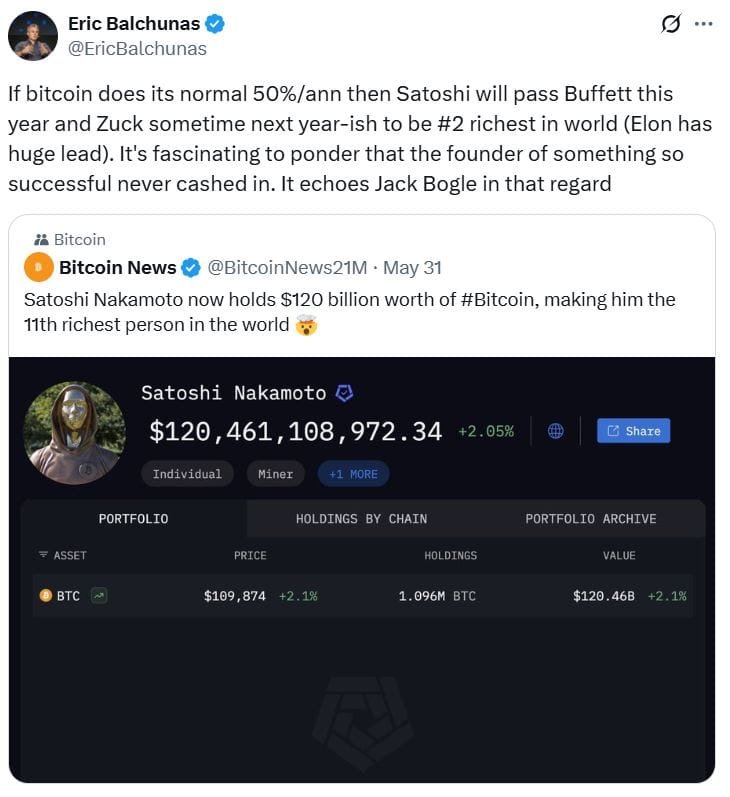
How the world’s richest stack up today
According to Forbes, here’s how the top billionaire rankings currently look:
- Elon Musk – $404B
- Larry Ellison – $274B
- Mark Zuckerberg – $274B
- Bernard Arnault – $198B
- Jeff Bezos – $197B
- Warren Buffett – $139B
- Bill Gates – $129B
- Michael Bloomberg – $127B
- Steve Ballmer – $126B
- Michael Dell – $125B
- Satoshi Nakamoto – $133B (if counted)
What makes Satoshi stand apart from every name on that list? Every other person is connected to public companies, IPOs, and regulatory frameworks. Satoshi’s wealth exists entirely outside of traditional finance.
Could Satoshi ever spend it?
This is where things get philosophical. Even if Satoshi wanted to cash out, moving any of those coins would instantly trigger massive scrutiny — and possibly panic.
Any transaction from the original wallets would make global headlines, crash markets temporarily, and possibly reveal Satoshi’s identity if traced carefully. It would also create tax liabilities and regulatory complications on a scale never seen before.
And yet, Satoshi has done none of that. Not even during 2011’s first bull run. Not during 2017’s mania, and not during 2021’s peak. And now, not in 2025.
That kind of restraint is almost mythical. It’s what makes the story more powerful than just the number. It’s a new kind of billionaire — one who doesn’t seek to consume, but to disappear.
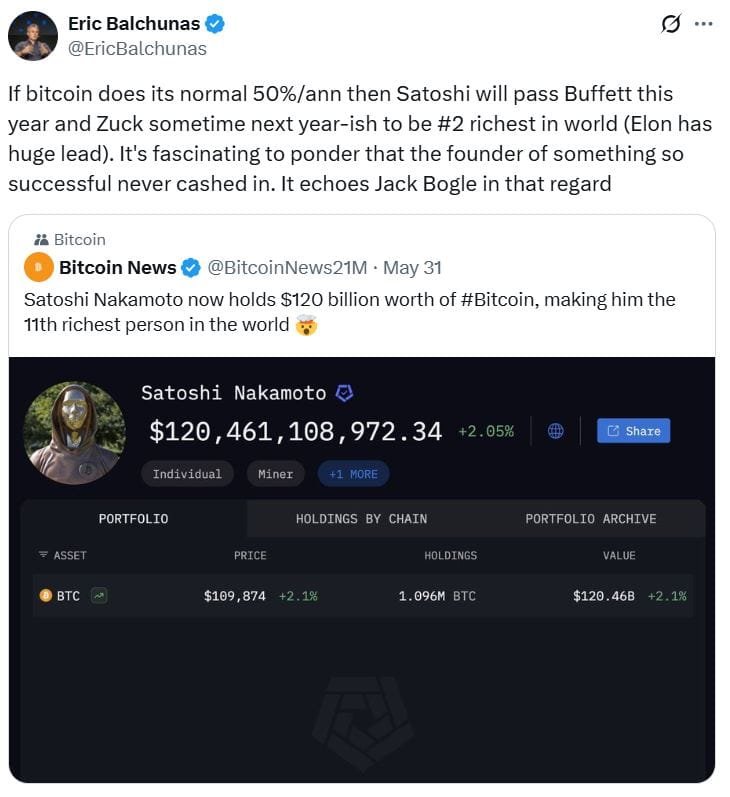
The shadow of Jack Bogle
Eric Balchunas compared Satoshi to Jack Bogle, the founder of Vanguard and the inventor of the index fund. Despite creating trillions in value for the world, Bogle died in 2019 with a net worth of just $80 million.
He never chased profit. He didn’t exploit his invention, and he let it serve people.
Satoshi may be echoing that legacy, letting the network grow without touching the coins. It creates legitimacy, trust, and ideological purity. It also ensures that Bitcoin remains decentralised in spirit, not just in code.
What about other Bitcoin whales?
While Satoshi holds the largest personal stash, several other names are worth noting:
- The Winklevoss twins: Approx. 70,000 BTC each (via Gemini)
- Tim Draper: Around 30,000 BTC (from a 2014 US Marshals auction)
- Michael Saylor: Holds 17,732 BTC personally (outside of MicroStrategy’s treasury)
- Public companies + custodians: Combined, they hold approx. 847,000 BTC (about 4% of total supply)
Still, no one comes close to Satoshi’s 1.096 million BTC — nearly 5.2% of all Bitcoin that will ever exist.
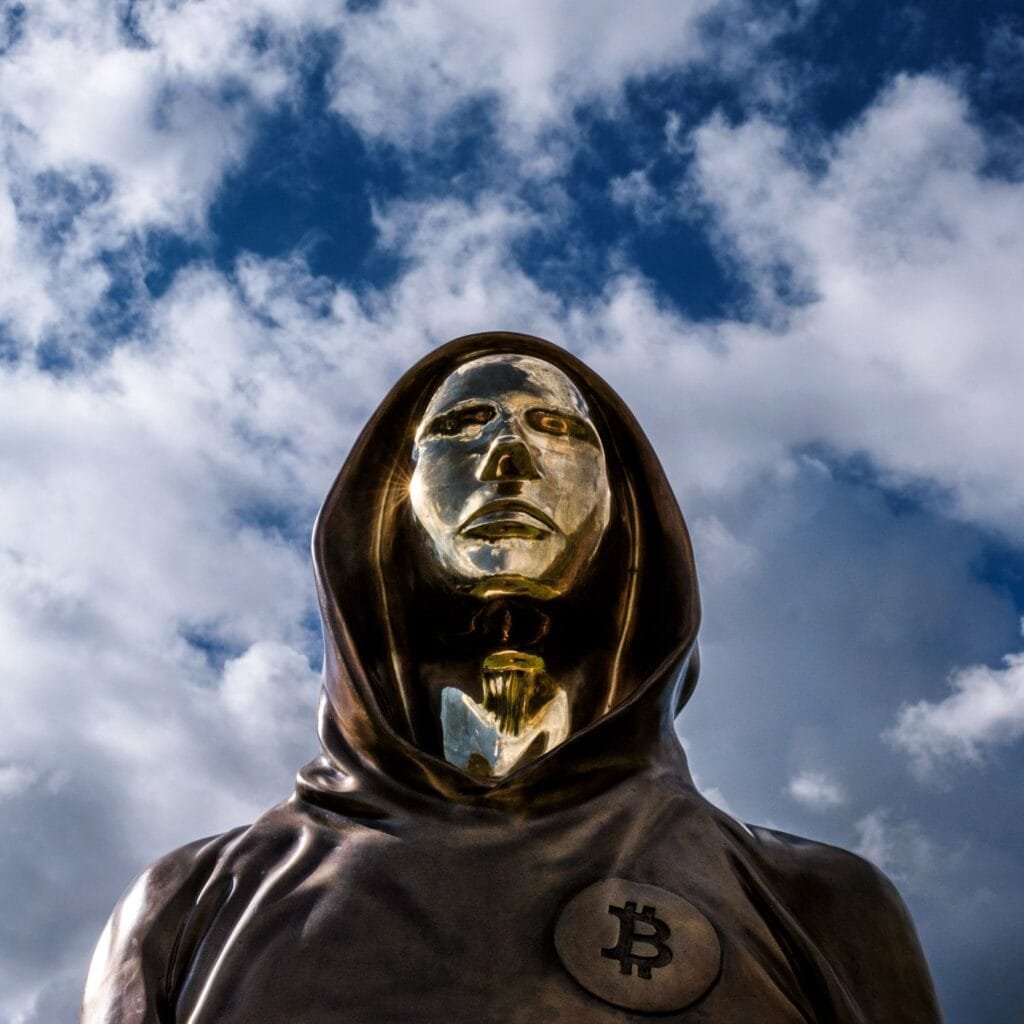
Institutional fuel: Why the price could keep rising
Bitcoin’s current bull cycle is being powered not by retail traders but by some of the world’s largest institutions.
- BlackRock’s Bitcoin ETF was approved earlier this year
- Fidelity, Franklin Templeton, and VanEck have joined the party
- Goldman Sachs and JP Morgan are now offering crypto custody and exposure products to clients
- Sovereign wealth funds, including in the UAE and Singapore, are rumoured to be accumulating BTC
As supply becomes increasingly scarce and traditional institutions pour in, the case for Bitcoin hitting $200K–$300K in the next two years becomes more plausible, especially if global inflation and distrust in fiat currencies persist.
The ultimate paradox
The world’s most elusive inventor is on the cusp of becoming its richest. And he may never know — or care.
That’s the paradox of Satoshi Nakamoto. In a world obsessed with influence, visibility, and monetisation, Satoshi chose silence. In a world where billionaires tweet, launch rockets, and flaunt yachts, Satoshi’s only legacy is code — and the decentralised trust it created.
And that might be the most radical form of wealth we’ve ever seen.
On-Chain Questions
Satoshi is believed to hold approximately 1.096 million Bitcoin, mined during the first two years of Bitcoin’s existence. These coins remain untouched and are tracked across thousands of wallets.
Not yet. Elon Musk’s net worth exceeds $400 billion. For Satoshi to surpass that, Bitcoin would need to reach over $370,000 per coin — a 208% increase from current levels.
No one knows for sure. Many believe it’s a principled decision to keep Bitcoin decentralised and maintain confidence in the network. Spending the coins would likely disrupt market stability and attract global attention.
Yes. Several experts believe Satoshi may be a pseudonym for a group of cryptographers or developers. Despite speculation, no conclusive proof has ever identified the individual or team behind the name.



